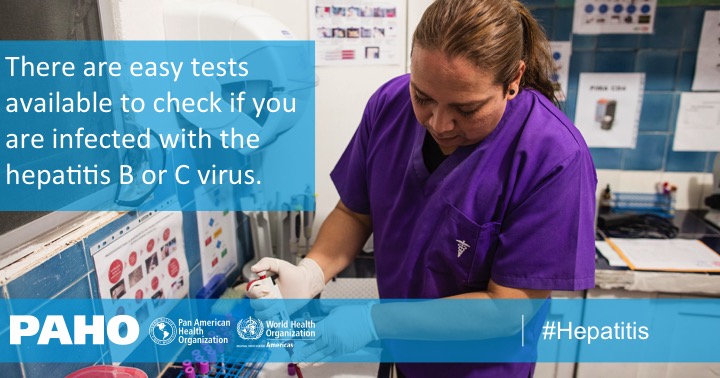July 28, 2018: World Hepatitis Day
 Viral hepatitis B and C are major public health challenges, affecting 325 million people globally. They are the root causes of liver cancer, leading to 1.34 million deaths every year.
Viral hepatitis B and C are major public health challenges, affecting 325 million people globally. They are the root causes of liver cancer, leading to 1.34 million deaths every year.
In the region of the Americas 3.9 million people live with chronic hepatitis B and 7.2 million with chronic hepatitis C resulting in over 125 000 deaths each year, a result of liver cancer and liver disease (cirrhosis)
Hepatitis B and C are chronic viruses that may not show symptoms for a long time following initial infection, sometimes years or decades. At least 60% of liver cancer cases are due to late testing and treatment of viral hepatitis B and C. Low coverage of testing and treatment is the most important gap to be addressed in order to achieve the global elimination goals by 2030.
WHO will focus on the theme: "Test. Treat. Hepatitis" for World Hepatitis Day 2018 events. WHO events and activities can aim to achieve the following objectives globally, in regions and in countries: (a) To support urgent scale-up of hepatitis prevention, testing, treatment and care services, with specific focus on promoting WHO testing and treatment recommendations; (b) To showcase best practices and promote universal health coverage of hepatitis services; and (c) To improve partnerships and funding in the fight against viral hepatitis.
Timely testing and treatment of viral hepatitis B and C saves lives.
Five things You Should Know About Viral Hepatitis
1. Viral hepatitis can be fatal
- Viral hepatitis types A, B, C, D, and E can cause infection and subsequent liver inflammation that can lead to serious diseases, including liver cancer, or even death.
- People who contract hepatitis A and E almost always recover and do not need treatment.
- In the case of the B, C, and D viruses, the infection can become chronic and some patients may die of liver cancer or cirrhosis. However, if the infection is detected in time, it can be treated.
- Patients with the hepatitis C virus can recover completely.
- There are vaccines that protect against viral hepatitis A, B, D and E.
2. Some hepatitis viruses can also be transmitted sexually
- Hepatitis B, C, and D can be transmitted through blood, semen, and other body fluids. This means that these viruses can be transmitted during unprotected sex.
- The hepatitis B virus is ten times more infectious than HIV.
- A pregnant woman who has hepatitis B can transmit the virus to her child during birth. Administering the hepatitis B vaccine to newborns during the first 24 hours after birth is the most effective measure for protecting babies.
- Viral hepatitis A and E are often transmitted through unsafe water, contaminated food, and poor sanitation.
3. Do not share syringes or razors
- Viral hepatitis B, C, and D can be transmitted through an infected person's body fluids. People who inject drugs have a high risk of infection, since they sometimes share syringes.
- In order to avoid the risk of infection, do not share razors, syringes, or unsterilized instruments used for tattooing or piercing.
- Health services should always use safe syringes.
- Never share syringes.
4. Everyone over the age of 40 should be tested for the hepatitis C virus
- Before the 1990s, blood transfusions were not screened to detect viral hepatitis. Therefore, it is recommended that all people over the age of 40 be given a blood test to determine if they are carriers of the virus.
- People who have received a blood transfusion in a country that does not screen for viral hepatitis should also be tested.
5. Hepatitis C can lead to cirrhosis without apparent symptoms
- The hepatitis C virus can remain in a person's blood for up to 20 years without apparent symptoms, until it causes inflammation and damage to the liver, which can develop into chronic hepatitis, cirrhosis, or liver cancer. The good news is that hepatitis C can be cured. Today there are effective medicines that allow patients to make a full recovery in three months.



